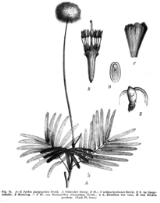
Parkia
Encyclopedia
Parkia is a genus
of flowering plant
s in the legume family
, Fabaceae
. It belongs to the subfamily Mimosoideae
.
In 1995, about 31 species
were known. Four more have been discovered since that time. The type species
for the genus is Parkia biglobosa
.
Parkias are found thruout the tropics
, with four species in Africa
, about 10 in Asia
, and about twenty in the neotropics. The neotropical species were revised in 1986.
Genus
In biology, a genus is a low-level taxonomic rank used in the biological classification of living and fossil organisms, which is an example of definition by genus and differentia...
of flowering plant
Flowering plant
The flowering plants , also known as Angiospermae or Magnoliophyta, are the most diverse group of land plants. Angiosperms are seed-producing plants like the gymnosperms and can be distinguished from the gymnosperms by a series of synapomorphies...
s in the legume family
Family (biology)
In biological classification, family is* a taxonomic rank. Other well-known ranks are life, domain, kingdom, phylum, class, order, genus, and species, with family fitting between order and genus. As for the other well-known ranks, there is the option of an immediately lower rank, indicated by the...
, Fabaceae
Fabaceae
The Fabaceae or Leguminosae, commonly known as the legume, pea, or bean family, is a large and economically important family of flowering plants. The group is the third largest land plant family, behind only the Orchidaceae and Asteraceae, with 730 genera and over 19,400 species...
. It belongs to the subfamily Mimosoideae
Mimosoideae
Mimosoideae is a subfamily of the flowering plant family Fabaceae characterized by flowers with small petals and numerous prominent stamens...
.
In 1995, about 31 species
Species
In biology, a species is one of the basic units of biological classification and a taxonomic rank. A species is often defined as a group of organisms capable of interbreeding and producing fertile offspring. While in many cases this definition is adequate, more precise or differing measures are...
were known. Four more have been discovered since that time. The type species
Type species
In biological nomenclature, a type species is both a concept and a practical system which is used in the classification and nomenclature of animals and plants. The value of a "type species" lies in the fact that it makes clear what is meant by a particular genus name. A type species is the species...
for the genus is Parkia biglobosa
Parkia biglobosa
Parkia biglobosa or Néré is a tree of the genus Parkia in the family Fabaceae. In West Africa, its fruits are fermented to a condiment called "soumbala" or "dawa-dawa"....
.
Parkias are found thruout the tropics
Tropics
The tropics is a region of the Earth surrounding the Equator. It is limited in latitude by the Tropic of Cancer in the northern hemisphere at approximately N and the Tropic of Capricorn in the southern hemisphere at S; these latitudes correspond to the axial tilt of the Earth...
, with four species in Africa
Africa
Africa is the world's second largest and second most populous continent, after Asia. At about 30.2 million km² including adjacent islands, it covers 6% of the Earth's total surface area and 20.4% of the total land area...
, about 10 in Asia
Asia
Asia is the world's largest and most populous continent, located primarily in the eastern and northern hemispheres. It covers 8.7% of the Earth's total surface area and with approximately 3.879 billion people, it hosts 60% of the world's current human population...
, and about twenty in the neotropics. The neotropical species were revised in 1986.
Species
- Parkia barnebyana
- Parkia bicolor
- Parkia biglobosaParkia biglobosaParkia biglobosa or Néré is a tree of the genus Parkia in the family Fabaceae. In West Africa, its fruits are fermented to a condiment called "soumbala" or "dawa-dawa"....
- néré - Parkia biglandulosa
- Parkia filicoidea
- Parkia javanicaParkia javanicaParkia javanica Lam., syn. Parkia roxburghii G. Don. is a plant of the genus Parkia in the family Fabaceae....
- Parkia lutea
- Parkia madagascariensis
- Parkia nana
- Parkia paya
- Parkia platycephala
- Parkia speciosaParkia speciosaParkia speciosa is a plant of the genus Parkia in the family Fabaceae...
- petai, twisted cluster bean, stink bean - Parkia timoriana - tree bean

